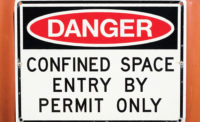On May the 4th of last year, OSHA announced an addition to 29 CFR 1926, the federal safety standards governing the construction industry. The rules for entering confined spaces specified in Subpart AA that took effect on August 3, 2015, represent a leap forward in efforts to protect construction workers who enter confined spaces as part of their daily duties. To help understand the reasons behind the new rules, let’s answer some of the common questions about confined space entry and the requirements for atmospheric testing.
Answers to common questions
Why was there previously no regulation regarding confined space entry in construction?
Twenty-two years ago, OSHA introduced the first regulations designed to protect workers entering confined spaces. 29 CFR 1910.146 clearly told us what a permit-required confined space was and dictated the rules for entry, particularly the requirements for testing and ensuring that the atmosphere inside the space would allow a worker to enter it safely.
However, 29 CFR 1910 only dictated the guidelines for safety in general industry while niche industries like construction were governed by other industry-specific OSHA standards. The gap was obvious years later when department of Labor statistics showed that from 2005-2009, sixty-one percent of all confined space fatalities occurred during construction, cleaning or repairing activities.
Are the new construction regulations the same as the previous general industry rules?
For the most part, the rules are very similar. The definition of a permit required confined space in construction is the same as a permit required confined space in any other industry: not designed for human occupancy, limited means of entry or egress, potential to contain a hazardous atmosphere.
The requirements for pre-entry testing are the same too; the atmosphere inside the space must be tested using a calibrated, direct-reading instrument for oxygen content, combustible gas and other potential toxic contaminants, in that order.
OSHA does take a step forward by clearly stating that the worker entering the space must be provided an opportunity to witness the testing that is intended to ensure his or her safety. This was not explicitly stated in the original industry rules.
I know that I have to test the atmosphere before someone enters a confined space, but what do I need a gas monitor for after that?
What happens after the testing and initial entry of the space according to the 1993 industry rules has been considered to be vague at best. In the general industry standard, it has been common to perform a pre-entry atmospheric test, complete the entry permit and put the gas monitor away until the next confined space entry.
But the new 2015 construction standard definitively changes that approach. 29 CFR1926.1203 clearly states that:
“…the atmosphere within the space must be continuously monitored unless the entry employer can demonstrate that equipment for continuous monitoring is not commercially available or periodic monitoring is sufficient. If continuous monitoring is used, the employer must ensure that the monitoring equipment has an alarm that will notify all entrants if a specified atmospheric threshold is achieved, or that an employee will check the monitor with sufficient frequency to ensure that entrants have adequate time to escape. If continuous monitoring is not used, periodic monitoring is required. All monitoring must ensure that the continuous forced air ventilation is preventing the accumulation of a hazardous atmosphere.”
The rule leaves little room for interpretation regarding what needs to be done with respect to atmospheric monitoring after initial entry into the space and once again OSHA reiterated that the entry worker is entitled to, and must be given, the opportunity to witness the testing intended for his or her protection.
What does the standard consider to be a direct reading instrument?
A direct reading instrument that complies with the requirements of the standards is one that can detect the hazards in the atmosphere and provide an immediate determination of the concentration level of each potential hazard within the space. The particular detection technology employed by the monitor is not relevant, only its ability to provide a direct concentration reading.
What does OSHA consider to be a “calibrated” instrument?
As well as the standards define what is and isn’t a confined space, and as clearly as the new construction regulations call out the need for continuous monitoring beyond the initial entry testing, there is still a big hole left in what constitutes a “calibrated” direct reading instrument. The standards themselves give no direction. OSHA interpretations have always been that “calibrated” means that a monitor is calibrated and maintained according to the manufacturer’s recommendations.
What about functional testing or “bump testing” of my gas monitor. Is it required by the new standard?
Bump testing is not mentioned in the regulations at all and is not a requirement of the standard. However, most views would be that users are expected to follow the manufacturer’s guidelines with regard to the bump testing of their monitors just as with calibration.
The question not asked
The question that is not asked is whether or not the standards go far enough when it comes to calibration and functional testing of atmospheric monitors. The standard does not have any specific requirements regarding frequency of calibration or how recent the last calibration is with respect to a particular entry.
Should the standards leave the rule-making up to the equipment manufacturers when it comes to ensuring that monitors used for critical atmospheric testing are functioning properly and accurately each time they are used? Although most manufacturers have taken the high road on calibration and test frequency, at least to cover their own liability, in soft industrial market conditions as we see today in sectors where confined space entry is prevalent, the demands of confined space owners and operators to reduce costs and the needs of equipment manufacturers to sell products could easily overshadow the best practices in safety.
Once again, I will call on the rule-makers to step up and clearly require the direct reading instruments used for confined space entry testing to be calibrated on a minimum monthly basis and function tested prior to daily use.
May 4, 2015 was a landmark day in construction safety and hopefully the rules established there will spill over and be adopted in every other industry. Strictly following those rules and applying the answers to these questions will be giant steps toward ensuring that everyone who enters a confined space will exit it at the end of the day alive.




